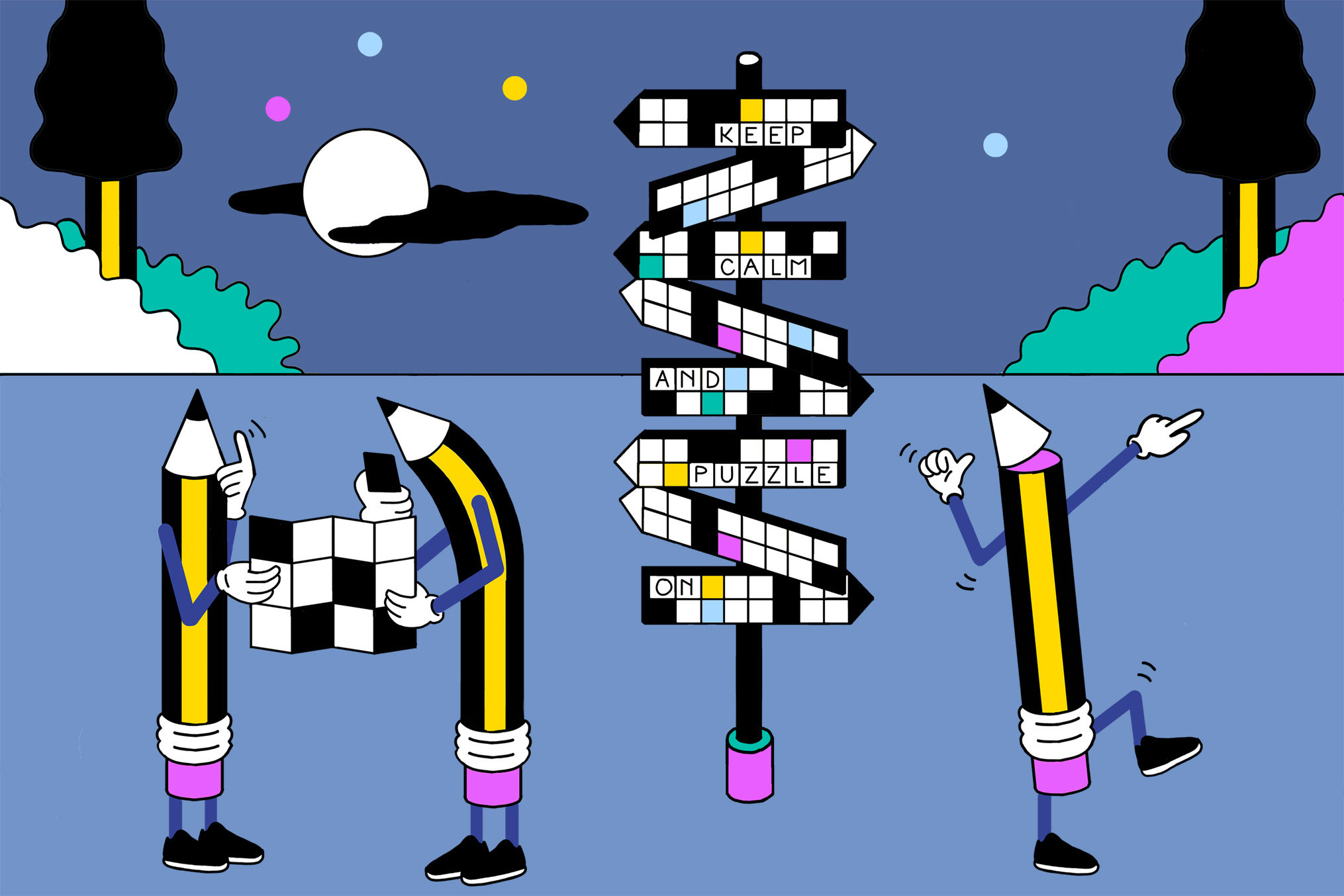RECORDS & PUZZLES OF NOTE
01
Notable Records and Puzzles
Fans of the Times crossword have kept track of a number of records and interesting puzzles (primarily from among those published in Shortz's tenure), including those below. (All puzzles published from November 21, 1993, on are available to online subscribers to the Times crossword.)
- Fewest words in a daily 15x15 puzzle: 50 words, on Saturday, June 29, 2013, by Joe Krozel; in a Sunday puzzle: 118 words on June 11, 2023, by Sam Ezersky.
- Most words in a daily puzzle: 86 words on Tuesday, December 23, 2008, by Joe Krozel; in a 21x21 Sunday puzzle: 150 words, on June 26, 1994, by Nancy Nicholson Joline and on November 21, 1993, by Peter Gordon (the first Sunday puzzle edited by Will Shortz).
- Fewest black squares (in a daily 15x15 puzzle): 17 blocks, on Friday, July 27, 2012, by Joe Krozel.
- Most prolific author: Manny Nosowsky is the crossword constructor who has been published most frequently in the Times under Shortz, with 241 puzzles (254 including pre-Shortz-era puzzles, published before 1993), although others may have written more puzzles than that under prior editors. The record for most Sunday puzzles is held by Jack Luzzato, with 119 (including two written under pseudonyms); former editor Eugene T. Maleska wrote 110 himself, including 8 under other names.
- Youngest constructor: Daniel Larsen, aged 13 years and 4 months.
- Oldest constructor: Bernice Gordon was 100 on August 11, 2014, when her final Times crossword was published. (She died in 2015 at the age of 101.) Gordon published over 150 crosswords in the Times since her first puzzle was published by Margaret Farrar in 1952.
- Greatest difference in ages between two constructors of a single puzzle: 83, a puzzle by David Steinberg (age 16) and Bernice Gordon (age 99) with the theme AGE DIFFERENCE.
- 15-letter-word stacks: On December 29, 2012, Joe Krozel stacked five 15-letter entries, something never before or since achieved. Krozel, Martin Ashwood-Smith, George Barany and Erik Agard have stacked four 15-letter entries in a puzzle. Since 2010, Krozel, Ashwood-Smith, Kevin G. Der, and Jason Flinn have stacked two sets of four 15-letter entries in a puzzle.
- Lowest word count for a debut puzzle: 62 words, on Saturday, June 1, 2019, by Ari Richter.

Crosswords that Gained Further Recognition
A few crosswords have achieved recognition beyond the community of crossword solvers. Perhaps the most famous is the November 5, 1996, puzzle by Jeremiah Farrell, published on the day of the U.S. presidential election, which has been featured in the movie Wordplay and the book The Crossword Obsession by Coral Amende, as well as discussed by Peter Jennings on ABC News, featured on CNN, and elsewhere. The two leading candidates that year were Bill Clinton and Bob Dole; in Farrell's puzzle, one of the long clue/answer combinations read [Title for 39-Across next year] MISTER PRESIDENT. The remarkable feature of the puzzle is that 39-Across could be answered either CLINTON or BOB DOLE, and all the Down clues and answers that crossed it would work either way (e.g., [Black Halloween animal] could be either BAT or CAT depending on which answer you filled in at 39-Across; similarly [French 101 word] could equal LUI or OUI, etc.). Constructors have dubbed this type of puzzle a Schrödinger or quantum puzzle after the famous paradox of Schrödinger's cat, which was both alive and dead at the same time. Since Farrell's invention of it, 16 other constructors—Patrick Merrell, Ethan Friedman, David J. Kahn, Damon J. Gulczynski, Dan Schoenholz, Andrew Reynolds, Kacey Walker and David Quarfoot (in collaboration), Ben Tausig, Timothy Polin, Xan Vongsathorn, Andrew Kingsley and John Lieb (in collaboration), Zachary Spitz, David Steinberg and Stephen McCarthy have used a similar trick.
In another notable Times crossword, 27-year-old Bill Gottlieb proposed to his girlfriend, Emily Mindel, via the crossword puzzle of January 7, 1998, written by noted crossword constructor Bob Klahn. The answer to 14-Across, [Microsoft chief, to some] was BILLG, also Gottlieb's name and last initial. 20-Across, [1729 Jonathan Swift pamphlet], was A MODEST PROPOSAL. And 56-Across, [1992 Paula Abdul hit], was WILL YOU MARRY ME. Gottlieb's girlfriend said yes. The puzzle attracted attention in the AP, an article in the Times itself, and elsewhere. Other Times crosswords with a notable wedding element include the June 25, 2010, puzzle by Byron Walden and Robin Schulman, which has rebuses spelling I DO throughout, and the January 8, 2020, puzzle by Joon Pahk and Amanda Yesnowitz, which was used at the latter’s wedding reception.
On May 7, 2007, former U.S. president Bill Clinton, a self-professed long-time fan of the Times crossword, collaborated with noted crossword constructor Cathy Millhauser on an online-only crossword in which Millhauser constructed the grid and Clinton wrote the clues. Shortz described the President's work as "laugh out loud" and noted that he as editor changed very little of Clinton's clues, which featured more wordplay than found in a standard puzzle. Clinton made his print constructing debut on Friday, May 12, 2017, collaborating with Vic Fleming on one of the co-constructed puzzles celebrating the crossword's 75th Anniversary.
The Times crossword of Thursday, April 2, 2009, by Brendan Emmett Quigley, featured theme answers that all ran the gamut of movie ratings—beginning with the kid-friendly "G" and finishing with adults-only "X" (now replaced by the less crossword-friendly "NC-17"). The seven theme entries were GARY GYGAX, GRAND PRIX, GORE-TEX, GAG REFLEX, GUMMO MARX, GASOLINE TAX, and GENERATION X. In addition, the puzzle contained the clues/answers of [Weird Al Yankovic's "__ on Jeopardy"] for I LOST and ["I'll take New York Times crossword for $200, __"] for ALEX. What made the puzzle notable is that the prior night's episode of the US television show Jeopardy! featured video clues of Will Shortz for five of the theme answers (all but GARY GYGAX and GENERATION X) which the contestants attempted to answer during the course of the show.